
Transcription
Ankur Pandey et al, / (IJCSIT) International Journal of Computer Science and Information Technologies, Vol. 3 (6), 2012,5369-5373Application Level Security in Cloud ComputingAnkur Pandey,Kirtee Shevade, Roopali SoniThakral College of TechnologyBhopal,India.ABSTRACT: Cloud Computing represents a new computing modelthat poses many demanding security issues at all levels, e.g.,network, host, application, and data levels. The variety of thedelivery models presents different security challenges dependingon the model and consumers' Quality of ,Availability,Authenticity, and Privacy are essential concerns for both Cloudproviders and consumers as well. Infrastructure as a Service(IaaS) serves as the foundation layer for the other deliverymodels, and a lack of security in this layer affects the otherdelivery models, i.e., PaaS, and SaaS that are built upon IaaSlayer. Information Technology (IT) Security Risk Management isa critical task for the organization to protect against the loss ofconfidentiality, integrity, and availability of IT resources anddata. Due to system complexity and sophistication of attacks, it isincreasingly difficult to manage IT security risk. So this paperdeals with Security at the application level in cloud.1. INTRODUCTIONThe aim of this paper is to do research on security in CloudComputing by authenticating a Blob by some secure algorithmlike HMAC for an account [12]. First step of the research is toknow about the security principle for designing a solution thatwas specified by NIST for Cloud Security policies andmanagement. Next we must understand the concept ofAuthentication, Identification and Authorization. After that wemust understand the concept of Storage Account which will beused for authentication purpose and then we need to knowabout Blob for which the access will be provided for certainduration of time. By applying algorithms like HMAC [10] [12]we are going to generate the access key which will be uniqueand the probability of generating the same key will be very rareand the key will be valid for only certain period of time andafter that period the key will get expired.2. MOTIVATIONThe users of cloud computing work with application and datathat is not located at their premise. So the organizations arealso uncomfortable with this idea and there is also lack ofknowledge about this. The goal of this research is to provide anauthentication mechanism for the users of cloud services forlimited period of time in a stepwise fashion3. FUNCTIONALITY OF CLOUD COMPUTINGThe concept of cloud was introduced by Amazon. Amazon wasin the business of selling goods and gift items. In the peakseason like Christmas, lots of people use to buy gift items andother goods, so the load on their server increases to greatextent. In order to run their business smoothly, they increasedtheir server capability. But what about off season, the serverswere idle and they have to be kept running which in turnwww.ijcsit.comconsumes lots of power and at the same time power wasconsumed in cooling them. So the Amazon decided to rent outtheir servers in the off season to others, such that they canmake money out of it. This is how the concept of cloudcomputing evolved as Infrastructure as a Service (IaaS). Laterthe concept of Platform as a service (Paas) and Software as aService (Saas) evolved.Software-as-a-Service(SaaS): The SaaS service model offersthe services as applications to the consumer, usingstandardized interfaces. The services run on top of a cloudinfrastructure, with cloud infrastructure being invisible for theconsumer. The responsibility of the management theapplication, operating systems and underlying infrastructurelies within the domain of cloud provider. The consumer canonly control some of the user-specific applicationconfiguration settings.Platform-as-a-Service (PaaS): The PaaS service model offersthe services as operation and development platforms to theconsumer. The consumer can use the platform to develop andrun his own applications, supported by a underlying cloudbased infrastructure. “The consumer does not manage orcontrol the underlying cloud-based infrastructure includingnetwork, servers, operating systems, or storage, but has controlover the deployed applications and possibly application hostingenvironment configurations” .The cloud provider is responsiblefor the management of operating systems, network, serversand other computing resources.Infrastructure-as-a-Service (IaaS): The IaaS service model isthe lowest service model in the technology stack, offeringinfrastructure resources as a service, such as raw data storage,with processing power and increased network capacity. Theconsumer can the use IaaS based service offerings to deployhis own operating systems and applications, offering a widervariety of deployment possibilities for a consumer than thePaaS and SaaS models. It opens a new horizon for user fordeployment of resources with greater flexibility. “Theconsumer does not manage or control the underlying cloudinfrastructure but has control over operating systems, storage,deployed applications, and possibly limited control of selectnetworking components4. DRAWBACKS OF CLOUD4.1. SECURITY & PRIVACYUsers might not be comfortable handing over their datato a third party. This is an even greater concern when itcomes to companies that wish to keep their sensitiveinformation on cloud servers. Ensuring that a client’sdata is not accessed by any unauthorized users is ofgreat importance for any cloud service. To make theirservers more secure, cloud service vendors have5369
Ankur Pandey et al, / (IJCSIT) International Journal of Computer Science and Information Technologies, Vol. 3 (6), 2012,5369-5373developed password protected accounts, securityservers through which all data being transferred mustpass and data encryption techniques.4.2. DEPENDENCY (LOSS OF CONTROL ):QualityproblemswithCSP(CloudServiceProviders).No influence on maintenance levels and fixfrequency when using cloud services from a CSP. No orlittle insight in CSP contingency procedures, especiallybackup, restore and disaster recovery. No easymigration to another CSP. Measurement of resourceusage and end user activities lies in the hands of theCSP and tied to the financial health of anotherCompany.4.3. COSTWhile in the long run, cloud hosting is a lot cheaperthan traditional technologies, the fact that it’s currentlynew and has to be researched and improved actuallymakes it more expensive.4.4. DECREASED FLEXIBILITYThis is only a temporary problem (as the others on thislist), but current technologies are still in the testingstages, so they don’t really offer the flexibility theypromise. Of course, that’ll change in the future, butsome of the current users might have to deal with thefacts that their cloud server is difficult or impossible toupgrade without losing some data.4.5. KNOWLEDGE AND I NTEGRATION.More and deeper knowledge is required forimplementing and managing SLA contracts with CSP’s,Since all knowledge about the working of the cloud(e.g. hardware, software, virtualization, deployment) isconcentrated at the CSP, it is hard to get grip on theCSP. Integration with equipment hosted in other datacenters is difficult to achieve. Peripherals integration.(Bulk)Printers and local security IT equipment (e.g.access systems) is difficult to integrate. But also(personal) USB devices or smart phones or groupwareand email systems are difficult to integrate.5. RELATED WORKThere is a storage access key that is generated when we createa storage account and it is of 512 bits which may be used whenthe storage account is accessed and this is default one for theowner and our target in the research is to generate a differentkey each time who wanted to use the Blob and this key will bevalid for certain amount of time only and after that it will getexpired [3].6. SECURITY IN CLOUDThere are four layers of security which can be implemented in cloud [9].1. Physical security2. Operating System / Database Security3. Network security4. Application Security6.1. PHYSICAL SECURITYPhysical Security can be implemented by appointing a security guard onthe premises where our servers and sensitive data is present. He will takewww.ijcsit.comcare and will be responsible of all kind of accesses and entry for thatpremises and a record can be maintained either in hard copy or in softcopyof the persons entering or leaving the premises with their names, address,phone number, purpose, time of entry and exit, so that the personresponsible for any kind of future damage can be tracked down.6.2. OPERATING SYSTEM / DATABASE SECURITYNext level of security is the operating system and database security. Theneed for operating system based security is that any system can beglobally accessible through a set of vast inter and intra-networkconnections [9]. Another reason is transition motivated by the need towork remotely, convenience in accessing personal records. Convenienceand efficiency will increase security risks. The most important reason isthat even a single security loophole in the OS design known to a maliciousattacker could do serious damage [9]. For implementing operating systembased security in azure “Windows Live Id” is provided. There areSecurity Descriptors that represent access rights of a logged-in user. Thereis Object Manager that reads the security descriptors and passes on theinformation to the Security Reference Monitor (SRM). SRM determineswhether a user’s action is legal or illegal. We can encrypt file system forproviding security.6.3. NETWORK SECURITYNext level of security is network security where we can do the setup of afirewall which is going to monitor the incoming and outgoing traffic inour network. Now the question arises, that can be set up a firewall inazure? The answer is yes.6.3.1. CONTROLLING ACCESS TO YOUR DATA WITH THEFIREWALL IN AZUREThe source IP address is checked against a list of allowedsources before an incoming connection. If the source address isnot in this list, the connection is denied. There are no otherrules supported, just the list of allowed addresses. The list isstored in the master database for your SQL Azure databaseserver [4]. To manage your firewall rules through code, youcan create a connection to the master database with youradministrator account and use the provided stored procedures:sp set firewall rule will create a firewall rule, andsp delete firewall rule will remove a rule [4].6.4. APPLICATION SECURITYThe final level of security is application security in which the applicationcan only be accessed by providing some kind of credentials only and byproviding the type of credentials we can further divide the applicationsecurity in four types1. Identity based access2. Role based access3. Key based access4. Claim based access6.4.1. IDENTITY BASED ACCESSIn identity based access a username and password is provided by the userand if they matches with the records in the database then only the access isprovided otherwise the access is denied. Now the username can be ofmany types for example, name, email address, id proofs like drivinglicense number, pan card number, ssn number in America, Uid number inIndia etc which will uniquely identify that person. In case of email id wehave got additional advantage that in case of lost password we the issuingauthority can send the new password to that email id. We can also enjoythe advantage of email id with other identity types if we take email id asan input at the time of registering.5370
Ankur Pandey et al, / (IJCSIT) International Journal of Computer Science and Information Technologies, Vol. 3 (6), 2012,5369-53736.4.2. ROLE BASED ACCESSIn role based identity a role is associated with the user like administrator,developer etc and the application changes the view according to the roleof that user. Other credentials are also stored while issuing the role basedidentity to that user for security purpose.6.4.3. KEY BASED ACCESSIn key based identity the end user is provided a key and by using that keyonly the end user can access the services. This key is also stored in thedatabase for verification. This key is encrypted and is generally very longsuch that no one can guess it. The level of security is very high with keybased identity. It is generally associated with a time stamp and the servicescan only be enjoyed generally for certain amount of time only like 1 dayor 6 hours, 1month etc.6.4.4. CLAIM BASED ACCESSIn claim based identity a live id is created for a particular brand and allother services provided by that particular brand are accessed by that id.This is done because the end user or customer does not want to or doesnot prefer to create a new id and remembering the credentials each timefor using the different services of that particular brand. The end user neverlikes filling the form each time for different services of that particularbrand. So in order to attract customer to use their services without anypain and at the same time not compromising with the security claim basedidentity has been introduced and efforts and cost for maintain the data alsoreduce to great extent and at the same time we can track the data that howmany services and what type of the services has been accessed by aparticular type of person and this data can be used for data warehousingpurpose. The example of claim based identity is Google id which is samefor Gmail, Google , Blogspot, Google search etc. Similarly Windowslive id which is common for downloading all kinds of software providedfor Windows. Similarly facebook id which is not only accepted byfacebook but also accepted by websites of other brands also like Scribd asan additional type for login purpose.7. ALGORITHMStep 1: Design a classStep 2: Declare private members for the endpoint of Blob,account name and access keyStep 3: Create a containerStep 4: Upload a blob in the ContainerStep 5: Create a shared access signature based on a SharedAccess PolicyStep 6: Specify that we want read access or write access on ablob for say 30 minutes.Step 7: Create a Shared Access SignatureStep 8: Create a string to sign into the account with desiredpermissions with start and expiration timeStep 9: Create an HMACSHA256 instance from the access keyand by using it create an HMAC from the string to sign.Step 10: Use a shared access signature to initialize a StorageCredentials instance, which will be used to create a Cloud BlobClient. We use cloud blob client to construct the Cloud BlobContainer and download the content of a blob.Step 11: By using Http Web Request and Http Web Responsedownload of the content of a blob is made possible.www.ijcsit.com8. STORAGE ACCOUNTWindows Azure which is an operating system for cloudenvironment has Blob, Table and Queue services and a Storageaccount provides access to the application stored in it. So weneed a Storage Account to use Windows Azure storage [5].The amount of data that can be stored in a storage account isup to 100 TB in the form of Blob, queue and table. A singleuser can create up to five storage accounts in Windows Azure.The cost of storage can be based on the percentage utilizationof the storage as well as on the transactions required forreading, updating, adding and deleting the data stored. Forbilling average usage of the storage is calculated [5] [11].There are different types of storage policies which are based onredundancy to overcome failure and for continuation ofbusiness in case if one of the system goes down. There is georedundant storage (GRS) which are at the highest level ofdurability and like a dream replicating data at some otherlocation [11]. Here redundancy is the key for fault tolerantsystem. If there is failure at primary location then secondarylocation which is 100 of miles away from the primary locationis used for the continuation of the business. This feature can beturned on or off and it depends on the user requirement [11].There is another storage policy called locally redundant storagewhich is highly durable and available in nature. All theredundant storages are available at the same location and datais replicated three times. Windows Azure is a locally redundantsystem and if we need GRS then additional cost has to be paid.We can group storage accounts in cloud service deployment inWindows Azure and this grouping is called affinity group [6].We need to know about endpoints in storage account becausethey will be used while coding to represent the storage accountand the default format of the endpoints are as follows [11]:Blob ws.netTable ows.netQueue ows.netThere is a URL for accessing a storage account and is builtby appending the location of object by its endpoint in thestorage account. For example it may in the format t/mycontainer/myblob.8.1. BLOBS IN THE AZURE ECOSYSTEMIn Windows Azure system Blobs is the among the simpleststorage technique available. Blob stores the file in binaryformat that is why they are named as binary large object. Blobsare further classified in two types page Blobs and block Blobs,we are going to use block Blobs in our research. Steaming isthe purpose why these block Blobs are designed and read writeis the purpose why the page Blobs were designed. Themaximum size of block Blobs is 200 GB and that of pageBlobs is 1 TB. Blobs are use to store images and videos whereas in our local system we would have stored them in the filesof some folder. In Azure System Blobs are stored inContainers. There can be any number of containers in aWindows Azure account [11].The permissions that can be5371
Ankur Pandey et al, / (IJCSIT) International Journal of Computer Science and Information Technologies, Vol. 3 (6), 2012,5369-5373given to Blobs are public read or private and this access isdone at container level. The size of metadata that a containercan have is up to 8 KB. The maximum size of each Blob is upto 1 TB. Each blob is replicated minimum three times for thereason of scalability and protection of data. There are hot blobsalso who are served from multiple servers. The Developmentstorage Blobs can serve only 2 GB of data though a normalBlob can store 1 TB of data [11].8.2. MODEL FOR DATA STORAGE IN BLOBThere are four components in Blob Storage model and thesecomponents are as follows:a. Storage accountb. Containersc. Blobsd. Blocks or pagesWe can think of a container as a folder holding some files andthese files are Blobs. These Blobs contains one or more Blocksor pages of data [11]. We can get and set Access Control List(ACL) for containers. We can List all containers, create anddelete containers, retrieve and set properties and metadata ofall containers. Similarly we can create a Blob Container, access BlobStorage, upload Blobs to Containers, list the Files in a Blob Container,access Blobs and delete Blobs [11].8.3. Basic Mechanism for accessing the Blob:An application can be designed for uploading and then accessing theBlob. In Blobs we can store our data. But this data is not secure because itis public and anyone can access it. If we want to allow that certain personshould only access that data then some security mechanism should beimplemented in that application. We can also control the time of access byspecifying the time in that application which will be common for all. Fordesigning this application you should be aware of .net and programmingin Windows Azure. For designing this application we have write a WebRole, Design.aspx and .cs file. Web Role is used to handle the clientsreaching the front end, Design.aspx is used to provide the look and feel ofthe application and Event Handling is done to make the controls presenton the front end fire the events. The cs file is used to write the businesslogic for providing the security token and time for which that token isvalid.9. RESULTSWe have suggested the levels at which we can apply security in cloudcomputing. This differentiation at different levels will simplify theapproach for dealing with security issues in cloud and will help indeveloping a vision to work at which level for securing the cloudenvironment. There are two screenshots of the output of the twoapplication are attached, in which 1st screenshot represent the output inwhich security is not applied and with the help of url generated we candownload the Blob where as in 2nd screenshot after clicking the url aSecured access token is generated and now this is the only way throughwhich we can access the Blob. We can also see in the 2nd screenshot thatthe image is not visible even at the time of generation of token, so thesystem is secure. The time for accessing the Blob is also limited whichcan be changes according to requirement but it will be common for allThis ensures the Application level security in cloud by providing a tokenwhich is difficult to regenerate and remember.www.ijcsit.com10. FUTURE WORKIn Future we can work in AppFabric which is used to makechanges in operating system and we can enhance the securityof the Azure. Firewalls can also be used so we can suggestcertain measures which can increase the security of our data inAzure. We can also do research to uncover the securityloopholes of Azure and then we can suggest these loopholes toMicrosoft, so that they can avoid future attacks on Azure bytaking some remedy steps. For application level security wedesign application which are based on Claim based access andwe can use Id of facebook as an additional login credentials forlogging in the application.11. CONCLUSIONWe conclude with that we can implement Application levelsecurity in cloud by providing a shared access token. We havealso talked about other levels of security that can be applied incloud. We have also talked about different types of securityavailable in Application level security in particular. We havealso given the answer for implementing firewall in networklevel security in cloud. We have talked about some principlesthat should be kept in mind while proposing a solution forsecurity in cloud. We have also talked about the size of datathat can be stored in a blob. We have talked about theavailability of blobs in case of any failure and the models forcreating replicas to avoid the unavailability in case of anyfailure. In the end we have talked about secured as well asunsecured access of blob contents. So in total we have canmake sure that our data is more secure in Azure cloud than atour premises but we must have confidence in Microsoft so thatour interests are served.1.2.3.4.5.6.7.8.9.10.11.12.REFERENCESCloud Security: A Comprehensive Guide to Secure Cloud Computing,Ronald L. Krutz, Russell Dean VinesThe Cloud: Understanding the Security, Privacy and Trust Challenges,Neil Robinson, Lorenzo Valeri, Jonathan Cave & Tony Starkey (RANDEurope) Hans Graux (time.lex) Sadie Creese & Paul Hopkins(University of Warwick)Windows Aure step by Step, Roberto BrunnetiAzure in Action, , Chris Hey, Brain H PrinceData Storage Security in Cloud S.Sajithabanu, Dr.E.George Prakash RajAn Analysis of The Cloud Computing Security Problem, Mohamed AlMorsy, John Grundy and Ingo Müller Computer Science & SoftwareEngineering, Faculty of Information & Communication TechnologiesSwinburne University of Technology, Hawthorn, Victoria, AustraliaSecurity and Privacy in Cloud Computing: A Survey Minqi Zhou, RongZhang, Wei Xie, Weining Qian, Aoying Zhou Software EngineeringInstitute, East China Normal University, Shanghai 200062, China.National Institute of Information and Communications Technology,Kyoto 619-0289, JapanCloud Computing Security Issues and Challenges, Kuyoro S. O,Ibikunle F, Awodele O.Windows Azure Security Overview Charlie Kaufman andRamanathan VenkatapathyHmac Vs Mac, Layron Walker Master of Information Technology andInternet Security June 2010.Introducing the Azure Services Platform, David Chappell October2008.The Keyed-Hash Message Authentication Code (HMAC), Donald L.Evans, SecretaryU.S. Department of Commerce Technology5372
Ankur Pandey et al, / (IJCSIT) International Journal of Computer Science and Information Technologies, Vol. 3 (6), 2012,5369-537313.14.15.Administration Philip J. Bond, Under Secretary National Institute ofStandards and Technology Arden L. Bement, Jr., DirectorCloud Security Challenges and Solutions, Balraj S Boparai CISSP.Security in Cloud Computing by HMAC Algorithm Ankur Pandey(Mtech Scholar CSE) Thakral College of Technology BhopalIBM point of view: security and cloud computing.SCREEN SHOT – 1SCREEN SHOT - 2www.ijcsit.com5373
There are four layers of security which can be implemented in cloud [9]. 1. Physical security 2. Operating System / Database Security 3. Network security 4. Application Security 6.1. PHYSICAL SECURITY Physical Security can be implemented by appointing a security guard on the premises where our servers and sensitive data is present.










